안녕하세요?
미국 입양엄마가 자신의 10살짜리 딸과 펜팔을 할수 있는 또래 친구를 찾고 있습니다. 연락 주세요.
Add/Remove email notification | RSS Feed
Written by on date 2014-06-17 in Ask Volunteer .
안녕하세요?
미국 입양엄마가 자신의 10살짜리 딸과 펜팔을 할수 있는 또래 친구를 찾고 있습니다. 연락 주세요.
Written by on date 2014-06-16 in Ask Volunteer .
6/17(화) 오전 병원에 가는 입양인 통역해 주실분 구합니다.
병원: 광화문 구세군빌딩 5층 10시 30분
5호선 광화문 역 7번출구 에서 10시 10분 만남
Written by on date 2014-06-16 in Ask Volunteer .
6/20(금) 호텔에서 만나 도봉구 쌍문동에 위치한 한국사회봉사회(KSS) 방문 후 호텔로 돌아오는 일정 통역해 주실분 찾습니다...
시간: 09:30 (인사동 소재 Ibis Ambassador hotel) 만남
방문할 곳: KSS(한국사회봉사회) 10:30 약속
Written by on date 2014-06-14 in Notices .
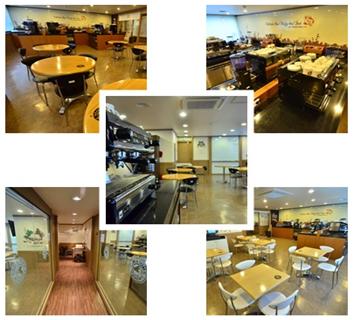
Purpose and Background
Firstly, a barista is a person, usually a coffeehouse employee, who prepares and serves espresso-based coffee drinks. In Korea, the coffee business is blooming and there are a lot of coffee shops. So, these companies need workers in order to effectively manage their coffee branches.
For this reason, we offer this education program to you. This program starts off with the understanding of coffee, shows you diverse ways to extract espresso from coffee beans and gives you an opportunity to make coffee. You can enjoy drinking and making coffee with other people and receive information regarding the career path of a barista through this program. This program will give you the opportunity to maintain economic stability in the future for yourself by increasing the ability to get an engage in a supportive community.
※ The syllabus (details of the curriculum) of the program can be found at the end.
※ IMPORTANT ※
The completion of this program DOES NOT make you a certified barista. You still need to take the barista exam. This program however, may prepare you for the barista exam.
If you want to take the barista exam, please continue reading.
You can register for the exam at "Tom N Toms Coffee Academy". If you pass the exam then you will become a coffee master level 2. There are two parts to the exam. The first part is a writing exam and the second part is a performance exam. You first need to pass the writing exam in order to take the performance exam. You should pay for the registration fee.
Registration fee : Writing Exam (30,000KWN) Performance Exam(50,000KWN)
Writing Exam Textbook(8,000KWN)
Dates for the Barista Program
※ IMPORTANT ※
How to Apply
Fill out an application through http://www.inkas.org/en/myservices/application/49/ If you are not an InKAS member, please sign up first and pay the annual membership fee.
Location
Seoul Special City Gangnam gu Shinsa dong 570-6 Bedro Building 5F Tom N Toms Academy
☎ 02-515-2345 / Fax: 02-515-2945 / Website: www.tomsacademy.com
Reference
Syllabus of the program
Week | Main Topics | Details |
1 | Orientation, understanding of coffee | Introduction of the program and Tom N Toms Academy, basic theories of coffee |
2 | Espresso Ⅰ | The definition of espresso and how to extract it, How to use an espresso machine |
3 | Espresso Ⅱ | Practice extracting espresso and correcting posture, Creating more difficult drinks by using espresso, Making espresso Con Panna and Americano |
4 | Espresso Ⅲ & Milk steam | Practice extracting espresso, Understanding steam and how it was made |
5 | Milk Steam Ⅰ | Practice making velvet steam, Dry & Wet cappuccino and Latte cappuccino |
6 | Milk Steam Ⅱ | Practice pouring wet cappuccino, Making design cappuccino |
7 | Making all the coffee from the coffee menu | Creating other drinks using syrup and powder, Practice making Caramel macchiato and Caffe mocha |
8 | Final Review and completion ceremony | Overview of barista exam details, Pre-test for barista exam, Completion Ceremony |
Written by on date 2014-06-13 in Ask Volunteer .
영어로 쓴 동생편지를 한국어로 번역해 주실 봉사자 구합니다.
A4 용지 한장 분량입니다.
Written by on date 2014-06-12 in Ask Volunteer .
1페이지 분량의 영어 편지 한국어로 번역해 주실분 댓글 주십시오.
감사합니다.
Bukchon Hanok Village
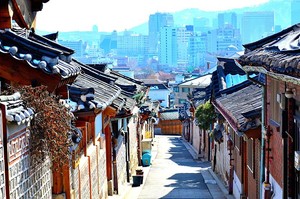
Bukchon Hanok Village is a Korean traditional village with a long history located between Gyeongbok Palace, Changdeok Palace and Jongmyo Royal Shrine. The traditional village is composed of lots of alleys, hanok and is preserved to show a 600-year-old urban environment. Now it is used as a traditional culture center and hanok restaurant, allowing visitors to experience the atmosphere of the Joseon Dynasty.
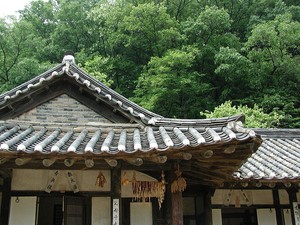
The area of Bukchon, which consists of neighborhoods: Wonseo-dong, Jae-dong, Gye-dong, Gahoe-dong and Insa-dong, was traditionally the residential quarter of high-ranking government officials and nobility during the Joseon Dynasty. It is located north of Cheonggye Stream and Jongno, hence named Bukchon, which means north village. A poll of nearly 2,000 foreign visitors, conducted by the Seoul Metropolitan Government in November 2011, stated that exploring the narrow streets of Bukchon was their fourth favorite activity in Seoul.
Namsangol Hanok Village
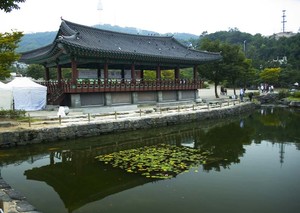
Namsangol Hanok Village, also known as "A Village of Traditional Houses in the Namsan Valley", is a Korean village located in the area of Pil-dong neighborhood in Jung-gu, a central district of Seoul, South Korea where hanok (한옥) or Korean traditional houses have been restored to preserve the original atmosphere of the area. The Namsangol Hanok Village offers one the opportunity to experience a wide cross-section of Joseon-era citizenry and activities, from royalty to commoners.
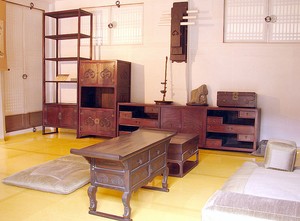
The location of the village was originally the site of a well known Joseon-era summer resort called Jeonghakdong. Jeonghakdong means "The land of the fairies for the blue crane where the Jeonugak Pavillion stands along the stream in the valley". The area boasted such superb scenery that it was called the land of the fairies and was considered one of the five most beautiful parts of Seoul.
A traditional Korean style garden, complete with a flowing stream and pavilion was constructed on the site in order to revive the classical feel of the Joseon-era. Five traditional houses, including some of the residences of high government officials - some of the largest mansions in Seoul at the time, along with commoners houses were moved to the 7,934 sq Meters/9,489 sq Yards grounds containing the restored village. In 2011 in a survey conducted, by Seoul Development Institute, which included 800 residents and 103 urban planners and architects. It listed 52.4 percent of experts, voted that the palace as the most scenic location in Seoul, following Mount Namsan, Han River and Gyeongbokgung Palace in the top spots.
Hahoe Folk Village
The Hahoe Folk Village (Korean: 안동하회마을) is a traditional village from the Joseon Dynasty. The village is a valuable part of Korean culture because it preserves Joseon period-style architecture, folk traditions, valuable books, and old tradition of clan-based villages.
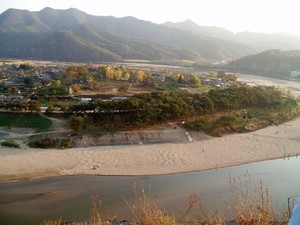
The village is located in Andong, Gyeongsangbuk-do. To the north of the village is Buyongdae Cliff while Mt. Namsan lies to the south. The village is organized around the geomantic guidelines of pungsu and so the village has the shape of a lotus flower or two interlocking comma shapes.
The village is listed by the South Korean government with UNESCO as a World Heritage site with Yangdong Folk Village in 2010.
The village maintains old architectural styles that have been lost because of rapid modernization and development in South Korea. Aristocratic tile-roofed residences and thatched-roof servants' homes preserve the architectural styles of the Joseon Dynasty. Wonjijeongsa Pavilion and Byeongsan Confucian School are two notable structures in the village. The village has preserved the shamanist rite of Byeolsin-gut and preserved Hahoe masks used in the Hahoe Mask Dance. Another rite still practiced is the Jeulbul Nori which uses strings of fireworks fired at the base of the Buyongdae Cliff.
Yangdong Folk Village
Yangdong Folk Village (Yangdong Village of Gyeongju) is a traditional village from the Joseon Dynasty. The village is located in Gangdong-myeon, sixteen kilometers northeast of Gyeongju, Gyeongsangbuk-do, South Korea, along the Hyeongsan River. Mt. Seolchang stands to the north of the village. The village is designated as Important Folklore Materials No. 189 by the South Korean government.
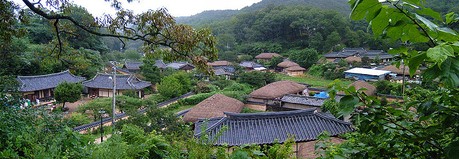
The size, degree of preservation, numerous cultural assets, traditionalism, beautiful natural setting all contribute to the importance of Yangdong Village. It is also a fine example of the yangban (Korean aristocracy) lifestyle and Neo-Confucian traditions.
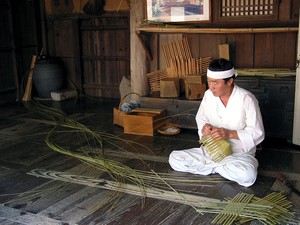
The village is listed by the South Korean government with UNESCO as a World Heritage site with Hahoe Folk Village in 2010.
Korean Folk Village
Minsok village is a living museum type of tourist attraction in the city of Yongin, a satellite city in the Seoul Metropolitan Area in the province of Gyeonggi in South Korea. Korean Folk Village is a popular tourist destination for both Koreans and foreigners. It is located near Everland, South Korea's largest amusement park.
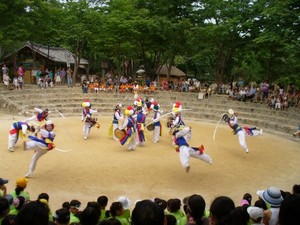
The purpose of Korean Folk Village is to display elements of traditional Korean life and culture. There are multiple sections to the park. There are numerous replicas of traditional houses of the different social classes (peasant, landowner, yangban) from various regions.

The park also has a traditional street market, restaurants, and showcases of traditional wordworking and metalworking techniques. There are performances of traditional dances, equestrian skills, marriage ceremonies, and recreational activities.
An amusement park section has rides and games, an art museum, a sculpture garden, a Korean Folk Museum, and a World Folk Museum which highlights traditional lifestyles from around the world.
Written by on date 2014-06-10 in Notices .
2014 InKAS Korean Language Scholarships for Fall Semester
InKAS provides Korean language scholarships to overseas Korean adoptees as an opportunity to learn the Korean language at a prestigious university in South Korea. In association with a grant from the Ministry for Health, Welfare and Family Affairs and the participating universities, scholarship grantees can study at any of these language institutes: Ewha Womans, Korea, Kyunghee, Seoul National, Sogang, Sangmyuung, Sookmyung Women’s and Yonsei University.
1. Required Documents and Terms
A. Documents
- One on-line application form (inkas.org)
- One photocopy of adoption document with your Korean name
- One photocopy of your passport with valid passport number
- One photocopy of your high school diploma or higher
- One photo (3x4cm)
B. Terms
- For students re-applying for a second semester, only an application form needs to be resubmitted, but some documents might be requested by InKAS or the university.
- If you have any problems or issues from previous semesters at the Korean language school, your application can be rejected or your acceptance may be cancelled by personal notification.
- An applicant must be at least 18 years old.
- Only fully-completed applications along with all the required documents will be accepted.
- Selections will be made entirely on a first-come first-served basis.
2. Application Deadline
- For all universities: 24:00, June 30th(Korean time)
3. How to apply
- Sign up or log into InKAS website ▷ Log in ▷ Our service ▷ Scholarship ▷ click on ‘Apply for scholarship’
- Fill out application form for 2014 fall scholarship ▷ Submit the completed form with all proper required documents
4. University information for language scholarships available through InKAS
University
Website
Course period
Course available through InKAS
Ewha Uni.
http://elc.ewha.ac.kr/EduKorean/eng/index.jsp
2014.09.02~2014.11.14
Intensive Program
Korea Uni.
http://klcc.korea.ac.kr/registration/registration_eng.html
2014.09.01- 2014.11.18
Regular Program
Kyunghee Uni.
http://kor.iie.ac.kr/contents/bbs/bbs_content.html?bbs_cls_cd=006001001
2014.09.29-2014.12.05
Regular Course
Sangmyung Uni.
http://cklc.smu.ac.kr/KLC/process_e.php
2014.09.15-2014.11.21
Regular Program
Seoul National Uni.
http://lei.snu.ac.kr/klec/
2014.09.01-2014.11.07
Regular Program
Sogang Uni.
https://klec.sogang.ac.kr/
2014.09.03-2014.11.18
Regular Course(20hrs/wk)
Sookmyung Uni.
http://www.lingua-express.com/mbs/KoreanEn/
2014.09.15-2014.11.25
Regular Morning
Yonsei Uni.
http://www.yskli.com/_en/default.asp
2014.09.25-2014.12.05
Regular Morning
* Classes run from 9a.m to 1p.m Monday through Friday
* The university information above can be changeable by university’s decision
* We do not offer scholarships for alternative language programs (evening or shorter-hour classes)
5. Fee
- InKAS Application fee: 82,000KW (77.00 USD) : It's non-refundable. Please don't pay before receiving an official scholarship award e-mail.
- University registration fee: Different terms apply for each university.
- Tuition fee: 50% covered for 6 of the universities.(30% covered for Sogang & Yonsei University.)
* Any previous scholarship cancellations can have a negative impact on your ability to receive another scholarship for 2014 Fall semester.
* Please check the university websites for spring semester schedule once again.
* If you are a recipient of a scholarship for the 2014 Fall semester, you will receive payment instructions and more information about this course by email.
For further inquiries regarding InKAS Korean Language Scholarships, please email or contact InKAS.
contact@inkas.org
02-3148-0258
안녕하세요 모국을 처음으로 방문하여 모든 것이 낯설을 수 있는 입양인들이 한국에서 모국 방문시 자유시간을 가질 동안 도와주실 자원 봉사자를 구합니다.
일시: 6월 26일 오전 10시 - 오후 5시
언어: 영어
* 점심 비용 및 입장료 등은 본인 부담
지하철로 이동, 서울 내 관광지역 등 방문시 한국어 통역 지원 등이 요함
봉사 가능하신 분들은 댓글 남겨주시기 바랍니다. 감사합니다.
Written by on date 2014-06-05 in Notices .
Korean Adoptee Art Exhibition Information Session
Calling all Korean adoptee artists living in South Korea! In collaboration with the Korean government, InKAS will be hosting an art exhibition in October. Through a selection process, we will be inviting 30 Korean adoptee artists and 30 established Korean artists. This will be a professional experience or all debuted and or debuting adoptee artists from all experiences and mediums.
Title: Info session for InKAS’ “SISO Art Exhibition”
Date: June 10th
Time: 6:30PM
Location: InKAS Office
If you want join contact wezzels2000@hotmail.com until 9th June 12:00